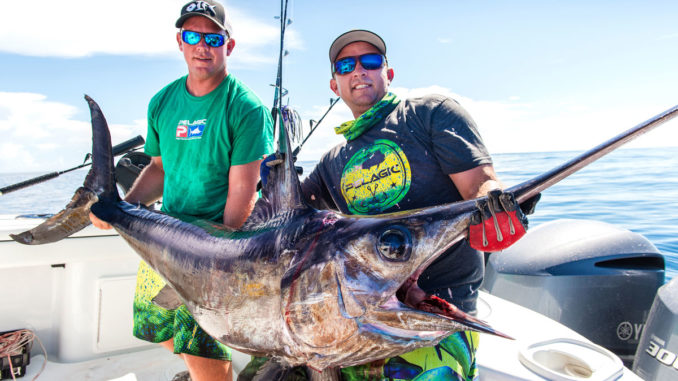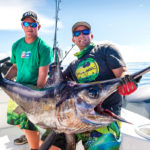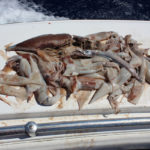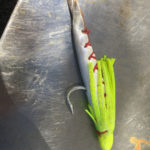
A developing fishery for broadbill swordfish is giving Carolinas anglers a chance to probe extreme depths for an extremely impressive trophy.
On a glassy day in the middle of the summer, Jacky DuFour sits at the helm of his 25-foot center console, the Merry Marlin. He’s well offshore of the usual trolling grounds, past the Big Rock, out of Beaufort Inlet. He has a single line in the water, which is more than 1,600 feet deep.
Both the captain and his charter fishermen are watching the tip of the rod intently for a subtle tap or just a slight change in angle signifying that something has taken more than a slight interest in his bait, which is just off of the bottom. With the braided line on the reel going almost straight down, DuFour is constantly on the helm, making slight adjustments to keep the line away from the props. He’s power-drifting, working directly against the current to go as slowly as possible.
He explains to his charter party that they are fishing over a small canyon. It’s not much to look at on the depth finder, and at 1,600 feet deep, there is no chance of marking individual fish or even clouds of bait on the machine, which has to be set to 50hz to handle the depth. He said he has caught swordfish from depths of 1,100 to 1,950 feet, and that it doesn’t take much on the bottom to find them. He has caught these fish over bottoms of sand, rock and mud. All he is looking for is a slight variation in the sea floor over which to drift.
It doesn’t take long before the rod tip taps three times, then goes down. Unlike a marlin bite, there is no initial screaming drag, just the rod settling into a long curve, almost like he is hung on the bottom. DuFour tells his angler to leave the rod in the holder to make sure the fish stays buttoned up for a few minutes, but as soon as the angler feels the fish, the tip comes up. All that’s left is the tension from the 12-pound sash weight. Just like that, the hook has pulled. Such is part of the swordfish game.
DuFour uses the electric drive on the Hooker-powered 80 wide Tiagra reel to retrieve his rig. Removing his light and unsnapping his sash weight from the floss loop on the rig, he cranks the mono topshot onto the reel. His bait, a stitched up dolphin belly, has been badly mangled, so he changes it out with a fresh one. A rubber squid skirt sits right in front of the bait to give it a little extra flash.
DuFour turns the boat to run directly downcurrent and sets out his bait. The weight and light are reattached just before the union of the 250-pound Monoi top shot to the 100-pound braid. He continues on his heading until he finds bottom with the weight, then retrieves just enough line to keep the weight right above the bottom, then starts a wide turn and puts the bow back into the current.
After about 20 minutes, the rod tip goes down again. This time, the fish stays hooked, and the angle of the line changes drastically as the angler hand-cranks the sword up from the depths. Swordfish are as unpredictable as they come when hooked, and this one is coming up while running away from the boat. Now the reel screams, the fish taking line seemingly at will. DuFour helps the angler move around to the bow for the best fighting angle. It’s an awesome sight when the 125-pound fish gets to the surface and goes aerial, slashing every which way with its bill. The sword isn’t close to done and goes on a series of runs and jumps. It’s a full 30 minutes later, with the drag lever pushed forward of the 17 pounds of strike drag, until the fish is boatside. DuFour puts a straight gaff in the sword to maneuver it, then tail-ropes the trophy.
Daniel Simmons targets swordfish well to the south on his 31-foot boat, Reel McCoy. Leaving from Shallotte or Little River inlets Simmons has a longer run to the swordfish grounds that DuFour, but he is able to fish the Beaufort Valley, a renowned swordfish ground. His tactics are similar to DuFour’s, but with two major differences. First, he prefers squid for his bait. Squid is a favorite meal of swordfish, most likely because they are so prolific at the depths where swords spend their days. They aren’t a durable bait, so Daniel salts his down heavily to toughen them up.
Additionally, Daniel likes to fish two rods. He will set a 150-foot topshot out first and make his turn, then set a 75-foot topshot out when he has his boat in the direction he wants to fish. It is a tricky job to make sure that these lines don’t tangle, so Daniel will check at least one of his baits more frequently than if he was fishing just one rod. However, there may well be a payoff, as Daniel had multiple successful trips in 2016, culminating in the 409-pounder he brought in to the Ocean Isle Fishing Center last July. That behemoth was found to be a “pumpkin” sword during cleaning; eating a specific type of crustacean turns the already prized meat orange, and it’s even more delicious.
DuFour said he gets swordfish bites on virtually all of his trips and lands adult swordfish on most. Swordfish have incredibly soft mouths, so he puts a premium on having J-style hooks that are absolutely razor sharp. Many of the fish he’s landed have had the hooks pull out of the original shot they took hold, but the hook point was able to penetrate secondary locations around the head. He has even caught fish that have been hooked in the tail, resulting in incredible fights.
Because of this, fluorocarbon is a poor choice for leader material because of its stiffness. Using a monofilament leader may require more changing due to abrasion, but it is more flexible than fluorocarbon, resulting in more opportunities to hook one of these “second-chance” fish.
For any angler chasing broadbill swordfish, there is a large initial investment in expensive gear. DuFour said a true swordfishing rod — he uses a Cal Star custom swordfish blank with AFTCO Bigfoot wind-on guides — and electric reel are indispensable when it comes to tangling with one of these brutes. The good news is that a dedicated swordfish angler only really needs two outfits to be successful. Fuel, tackle and ice also don’t come cheap when it comes to swordfish trips in the Carolinas. Unlike South Florida, where these daytime techniques were originally developed and refined, a trip from a North Carolina or South Carolina inlet might take a crew close to 100 miles offshore. With these long runs, however, there is an advantage.
Swordfish here get much less pressure then they typically get in the Florida Keys or the Gulf of Mexico. Daytime swordfishing is a developing fishery in the Carolinas. DuFour’s is the only charter operation that dedicates the bulk of its trips to swordfishing, but the fishery is growing by leaps and bounds.






Be the first to comment